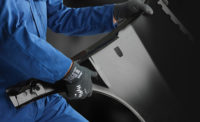"The woman was out for 18 months due to back and knee injuries," says Michael O. Ryan, president of Sampco, an 11-year-old manufacturer tucked away in Pittsfield in the state’s western corner. The company, which makes roofing and flooring displays for large home centers such as Home Depot, saw its insurance premiums rocket to $85,000 in 1995 because of workers’ compensation claims. The pallet accident cost $38,000, an exorbitant figure for the 65-person plant. Ryan told Shane Bleil, his safety and health coordinator and manager of quality assurance, that there were going to be plant-wide changes in order to lower injuries and costs.
Every little bit helps
Ryan invested in a consultant for long-term savings. Jay Karpin of Jay H. Karpin Associates in South Ryegate, Vt., came aboard to support Bleil’s safety reinvention efforts for three years. Karpin increased safety awareness on the five-employee safety committee through monthly meetings, encouraging the group to identify potentially hazardous situations. Together, they developed corrective actions and future means of preventive maintenance.An example of Karpin’s handiwork was the installation of push bars on doors instead of turn knobs, in case of fire. Another was training the in-house safety team to look for hazards, such as extension cords lying across walkways, and making sure fork truck horns were operating. "If they’re not, they are immediately disabled until they’re fixed," says Bleil.
With Karpin’s help, Bleil revamped portions of employee training. Now, he makes sure all employees know where MSDSs are located on the floor and how to handle Sampco’s chemical substances. He teaches new hires—and reiterates to veteran employees—how to prevent minor and more common injuries, such as burns from the hot melt adhesive dispensed onto boards to secure shingles, and what the proper medical treatment is should injury occur.
Then Ryan brought in the big guns—the Mass. Department of Labor (DOL)—to inspect Sampco. His logic: If inspectors are asked to come in on a consultative basis to help find possible hazards, Sampco can avoid injuries, citations and fines later on.
In 1996, Mass. OSHA officials crawled underneath machines and pointed out pinch points for hair and clothing where guards should be placed, and found knockouts where covers were needed. Inspectors told Ryan to take 45 days or more to correct more than two pages of violations before their next visit.
But Ryan still wanted another perspective on how to lower costs. So, Bleil contacted Sampco’s insurance carrier, Liberty Mutual, to provide suggestions.
Conducting its own audit, the insurer checked workstation height to make sure workers weren’t strained by improper seat adjustments. Auditors suggested anti-fatigue mats to reduce ergonomic injuries. A suggestion from Karpin—to compile smaller bundles of shingles to reduce back strains—also played up prevention in that area.
In all, Sampco spent more than $50,000 to turn around safety performance. Insurance premiums are down to a projected $52,000 for fiscal year 1998—compared to 1996 figures of $78,000—and Sampco hasn’t had a lost workday in almost a year and a half.
A healthy portfolio
Ryan instructed Bleil to apply for the Mass. Safety and Health Achievement Recognition Program (SHARP), which highlights companies dedicated to safety and health compliance. Sampco is now one of eight companies in Massachusetts exempt from surprise OSHA inspections. It plans to reapply to the program once its year-long agreement is up in early March. Liberty Mutual also acknowledged Sampco with an award for operating 6,000 hours without a lost-time accident following the SHARP designation. And Mass. DOL officials refer other companies with lockout-tagout problems to Sampco for guidance because its program is so stringent."If they [small companies] don’t invest in safety, they will pay for it later in premiums, claims and employee morale," says Ryan.

